
Mission San Carlos Borromeo del Río Carmelo, or Misión de San Carlos Borromeo de Carmelo, first built in 1797, is one of the most authentically restored Roman Catholic mission churches in California. Located at the mouth of Carmel Valley, California, it is on the National Register of Historic Places and is a National Historic Landmark.

Mission San Antonio de Padua is a Spanish mission established by the Franciscan order in present-day Monterey County, California, near the present-day town of Jolon. It was founded on July 14, 1771, and was the third mission founded in Alta California by Father Presidente Junípero Serra. The mission was the first use of fired tile roofing in Upper California. Today the mission is a parish church of the Diocese of Monterey and is no longer active in the mission work which it was set up to provide.
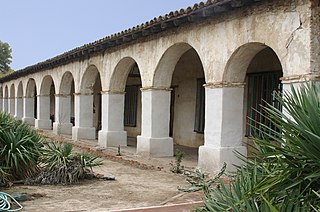
Mission San Miguel Arcángel is a Spanish mission in San Miguel, San Luis Obispo County, California. It was established on July 25, 1797 by the Franciscan order, on a site chosen specifically due to the large number of Salinan Indians that inhabited the area, whom the Spanish priests wanted to evangelize.

The Alamo Mission, commonly called the Alamo and originally known as the Misión San Antonio de Valero, is a historic Spanish mission and fortress compound founded in the 18th century by Roman Catholic missionaries in what is now San Antonio, Texas, United States. It was the site of the Battle of the Alamo in 1836. Today it is a museum in the Alamo Plaza Historic District and a part of the San Antonio Missions World Heritage Site.
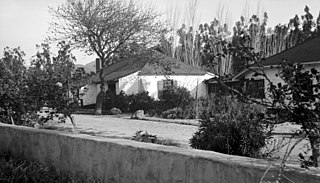
Rancho Camulos, now known as Rancho Camulos Museum, is a ranch located in the Santa Clara River Valley 2.2 miles (3.5 km) east of Piru, California and just north of the Santa Clara River, in Ventura County, California. It was the home of Ygnacio del Valle, a Californio alcalde of the Pueblo de Los Angeles in the 19th century and later elected member of the California State Assembly. The ranch was known as the Home of Ramona because it was widely believed to have been the setting of the popular 1884 novel Ramona by Helen Hunt Jackson. The novel helped to raise awareness about the Californio lifestyle and romanticized "the mission and rancho era of California history."

Las Trampas or just Trampas, is a small unincorporated town in Taos County, northern New Mexico, the Southwestern United States. Founded in 1751, its center retains the original early Spanish colonial defensive layout from that time, as well as the 18th-century San José de Gracia Church, one of the finest surviving examples of Spanish Colonial church architecture in the United States. The village center was designated a National Historic Landmark District in 1967.
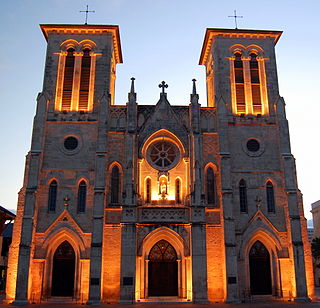
San Fernando Cathedral also called the Cathedral of Our Lady of Candelaria and Guadalupe is a cathedral of the Roman Catholic Church located in downtown San Antonio, Texas, USA, facing the city's Main Plaza. It is the mother church of the Archdiocese of San Antonio and the seat of its archbishop. Its dome serves as the city of San Antonio's cultural and geographical center. The cathedral is also known as the Church of Nuestra Señora de la Candelaria y Guadalupe and is listed on the National Register of Historic Places. It is notable as one of the oldest cathedrals in the United States.

The Camino Real de Tierra Adentro was an historic 2,560-kilometre-long (1,590 mi) trade route between Mexico City and San Juan Pueblo, New Mexico, USA, from 1598 to 1882. It was the northernmost of the four major "royal roads" that linked Mexico City to its major tributaries during and after the Spanish colonial era.

Burlingame is a Caltrain regional rail station in Burlingame, California. The station building was constructed in the Spanish Colonial Revival and Mission Revival architecture styles in 1894, opening for service on October 10 of that year. 18th-century tiles from the Mission San Antonio de Padua at Jolon and the Mission Dolores Asistencia at San Mateo were used for the station roof.
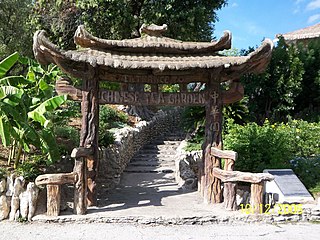
Dionicio Rodriguez (1891–1955) was a Mexican-born artist and architect whose work can be seen in Alabama, Arkansas, Illinois, Maryland, Michigan, New Mexico, Tennessee, and Texas, as well as Washington, D.C. and Mexico City.

The Hermitage of San Antonio de Padua de la Tuna near Isabela, Puerto Rico dates from 1730. It comprises the ruins of a village church that was abandoned in the early 19th century when the community, with the permission of Governor Salvador Meléndez, moved to a more favorable location nearer the coast, which became the town of Isabela, founded in 1819.

The Ysleta Mission, located in the Ysleta del Sur Pueblo within the municipality of El Paso, Texas, is recognized as the oldest continuously operated parish in the State of Texas. The Ysleta community is also recognized as the oldest in Texas and claims to have the oldest continuously cultivated plot of land in the United States.

Mission Nuestra Señora del Espíritu Santo de Zúñiga, also known as Aranama Mission or Mission La Bahía, was a Roman Catholic mission established by Spain in 1722 in the Viceroyality of New Spain—to convert native Karankawa Indians to Christianity. Together with its nearby military fortress, Presidio La Bahía, the mission upheld Spanish territorial claims in the New World against encroachment from France. The third and final location near Goliad, Texas is maintained now as part of Goliad State Park and Historic Site.

The Presidio Chapel of San Elizario was built in 1877 at the same place where an earlier Mexican chapel stood. The building is located in the central square of San Elizario, 17.5 miles south-southeast of El Paso. It was listed on the National Register of Historic Places in 1972. It is an example of the Spanish Colonial style.

San Antonio de Padua Church is a historic church along State Road 63 in Pecos, New Mexico. It was built during 1903 to 1906 and added to the National Register of Historic Places in 1978.

Goliad State Park and Historic Site is a 188.3 acres (76 ha) state park located along the San Antonio River on the southern edge of Goliad, Texas. It was listed on the National Register of Historic Places (#01000258) on March 12, 2001.
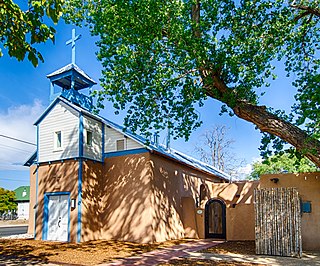
The Los Candelarias Chapel, also known as the San Antonio Chapel, is a historic building in Albuquerque, New Mexico. The chapel was built in 1888 to serve the community of Los Candelarias, one of several outlying plazas spread along the Rio Grande in the vicinity of the main plaza at Old Town Albuquerque. It is one of the only surviving buildings from the no-longer-extant plaza. The building remained in use as a chapel until the 1950s and was subsequently converted into an artist's studio and then a private residence. It was listed on the New Mexico State Register of Cultural Properties in 1983 and the National Register of Historic Places in 1984.

San Jose de los Duranes Chapel is a historic building in Albuquerque, New Mexico. The chapel was built around 1890 to serve the community of Los Duranes, one of several outlying plazas spread along the Rio Grande in the vicinity of the main plaza at Old Town Albuquerque. The chapel was replaced with a new, larger San Jose Church in the 1960s, and fell into disrepair. In 1982–4, community members undertook a restoration of the building, replacing damaged or missing pews, rails, and doors, plastering the walls, repairing holes, and reinstalling the original religious artwork including paintings of the Crucifixion and a santo depicting St. Joseph. It was listed on the New Mexico State Register of Cultural Properties in 1983 and the National Register of Historic Places in 1984.


















